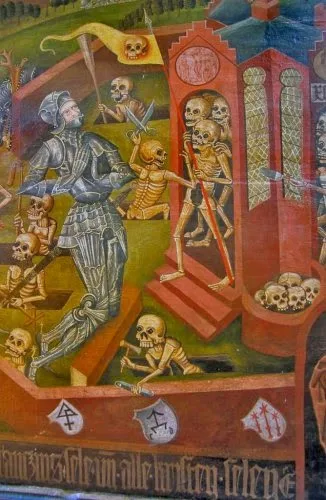Dance of Death, also variously called Danse Macabre (French), Danza Macabra (Italian), Dansul Morţii (Romanian), Ples Mrtvaca (Croatian), Danza de la Muerte (Spanish), Dansa de la Mort (Catalan), Dança Macabra (Portuguese), Totentanz (German), Dodendans (Dutch), Surmatants (Estonian), is an artistic genre of late-medieval allegory on the universality of death: no matter one's station in life, the Dance of Death unites all.
The Danse Macabre consists of the dead or personified Death summoning representatives from all walks of life to dance along to the grave, typically with a pope, emperor, king, child, and labourer. They were produced to remind people of the fragility of their lives and how vain were the glories of earthly life.Its origins are postulated from illustrated sermon texts; the earliest recorded visual scheme was a now lost mural in the Saints Innocents Cemetery in Paris dating from 1424–25.
The earliest recorded visual example is from the cemetery of the Church of the Holy Innocents in Paris (1424–25).
There were also painted schemes in Basel (the earliest dating from c.1440); a series of paintings on canvas by Bernt Notke, in Lübeck (1463); the initial fragment of the original Bernt Notke painting (accomplished at the end of the 15th century) in the St Nicholas' Church, Tallinn, Estonia; the painting at the back wall of the chapel of Sv. Marija na Škrilinama in the Istrian town of Beram (1471), painted by Vincent of Kastav; the painting in the Holy Trinity Church in Hrastovlje in Istria by John of Kastav (1490). There was also a Dance of Death painted in the 1540s on the walls of the cloister of St Paul's Cathedral, London with texts by John Lydgate, which was destroyed in 1549.
The deathly horrors of the 14th century—such as recurring famines; the Hundred Years' War in France; and, most of all, the Black Death—were culturally assimilated throughout Europe. The omnipresent possibility of sudden and painful death increased the religious desire for penitence, but it also evoked a hysterical desire for amusement while still possible; a last dance as cold comfort.
The danse macabre combines both desires: in many ways similar to the mediaeval mystery plays, the dance-with-death allegory was originally a didactic dialogue poem to remind people of the inevitability of death and to advise them strongly to be prepared at all times for death (see memento mori and Ars moriendi).
Short verse dialogues between Death and each of its victims, which could have been performed as plays, can be found in the direct aftermath of the Black Death in Germany and in Spain (where it was known as the Totentanz and la Danza de la Muerte, respectively). The French term danse macabre may derive from the Latin Chorea Machabæorum, literally "dance of the Maccabees." In 2 Maccabees, a deuterocanonical book of the Bible, the grim martyrdom of a mother and her seven sons is described, and was a well-known mediaeval subject. It is possible that the Maccabean Martyrs were commemorated in some early French plays or that people just associated the book's vivid descriptions of the martyrdom with the interaction between Death and its prey. An alternative explanation is that the term entered France via Spain, the Arabic: مقابر , maqabir (cemetery) being the root of the word. Both the dialogues and the evolving paintings were ostensive penitential lessons that even illiterate people (who were the overwhelming majority) could understand.
Furthermore, frescoes and murals dealing with death had a long tradition and were widespread, e.g. the legend of the Three Living and the Three Dead: on a ride or hunt, three young gentlemen meet three cadavers (sometimes described as their ancestors) who warn them, Quod fuimus, estis; quod sumus, vos eritis (What we were, you are; what we are, you will be). Numerous mural versions of that legend from the 13th century onwards have survived (for instance, in the hospital church of Wismar or the residential Longthorpe Tower outside Peterborough). Since they showed pictorial sequences of men and corpses covered with shrouds, those paintings are sometimes regarded as cultural precursors of the new genre.
A danse macabre painting may show a round dance headed by Death or a chain of alternating dead and live dancers. From the highest ranks of the mediaeval hierarchy (usually pope and emperor) descending to its lowest (beggar, peasant, and child), each mortal's hand is taken by a skeleton or an extremely decayed body. The famous Totentanz by Bernt Notke in Lübeck's Marienkirche (destroyed during the Allied bombing of Lübeck in World War II) presented the dead dancers as very lively and agile, making the impression that they were actually dancing, whereas their living dancing partners looked clumsy and passive. The apparent class distinction in almost all of these paintings is completely neutralized by Death as the ultimate equalizer, so that a sociocritical element is subtly inherent to the whole genre.
The Totentanz of Metnitz, for example, shows how a pope crowned with his mitre is being led into Hell by the dancing Death.
Usually, a short dialogue is attached to each victim, in which Death is summoning him (or, more rarely, her) to dance and the summoned is moaning about impending death. In the first printed Totentanz textbook (Anon.: Vierzeiliger oberdeutscher Totentanz, Heidelberger Blockbuch, approx. 1460),
Death addresses, for example, the emperor:




.png)


-1.jpg)


.jpg)













0 comments